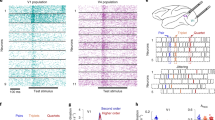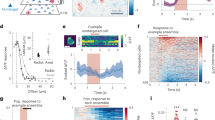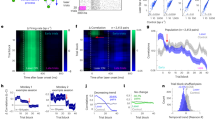Abstract
Cells throughout the CNS have synchronous activity patterns; that is, a cell's probability of generating an action potential depends both on its firing rate and on the occurrence of action potentials in surrounding cells. The mechanisms producing synchronous or correlated activity are poorly understood despite its prevalence and potential effect on neural coding. We found that neighboring parasol ganglion cells in primate retina received strongly correlated synaptic input in the absence of modulated light stimuli. This correlated variability appeared to arise through the same circuits that provide uncorrelated synaptic input. In addition, ON, but not OFF, parasol cells were coupled electrically. Correlated variability in synaptic input, however, dominated correlations in the parasol spike outputs and shared variability in the timing of action potentials generated by neighboring cells. These results provide a mechanistic picture of how correlated activity is produced in a population of neurons that are critical for visual perception.
This is a preview of subscription content, access via your institution
Access options
Subscribe to this journal
Receive 12 print issues and online access
$209.00 per year
only $17.42 per issue
Buy this article
- Purchase on Springer Link
- Instant access to full article PDF
Prices may be subject to local taxes which are calculated during checkout







Similar content being viewed by others
References
Usrey, W.M. & Reid, R.C. Synchronous activity in the visual system. Annu. Rev. Physiol. 61, 435–456 (1999).
Averbeck, B.B., Latham, P.E. & Pouget, A. Neural correlations, population coding and computation. Nat. Rev. Neurosci. 7, 358–366 (2006).
Meister, M., Lagnado, L. & Baylor, D.A. Concerted signaling by retinal ganglion cells. Science 270, 1207–1210 (1995).
Dan, Y., Alonso, J.M., Usrey, W.M. & Reid, R.C. Coding of visual information by precisely correlated spikes in the lateral geniculate nucleus. Nat. Neurosci. 1, 501–507 (1998).
Pillow, J.W. et al. Spatio-temporal correlations and visual signaling in a complete neuronal population. Nature 454, 995–999 (2008).
Romo, R., Hernandez, A., Zainos, A. & Salinas, E. Correlated neuronal discharges that increase coding efficiency during perceptual discrimination. Neuron 38, 649–657 (2003).
Zohary, E., Shadlen, M.N. & Newsome, W.T. Correlated neuronal discharge rate and its implications for psychophysical performance. Nature 370, 140–143 (1994).
Petersen, R.S., Panzeri, S. & Diamond, M.E. Population coding of stimulus location in rat somatosensory cortex. Neuron 32, 503–514 (2001).
Puchalla, J.L., Schneidman, E., Harris, R.A. & Berry, M.J. Redundancy in the population code of the retina. Neuron 46, 493–504 (2005).
Nirenberg, S., Carcieri, S.M., Jacobs, A.L. & Latham, P.E. Retinal ganglion cells act largely as independent encoders. Nature 411, 698–701 (2001).
Mastronarde, D.N. Correlated firing of retinal ganglion cells. Trends Neurosci. 12, 75–80 (1989).
Meister, M. Multineuronal codes in retinal signaling. Proc. Natl. Acad. Sci. USA 93, 609–614 (1996).
Field, G.D. & Chichilnisky, E.J. Information processing in the primate retina: circuitry and coding. Annu. Rev. Neurosci. 30, 1–30 (2007).
Schnitzer, M.J. & Meister, M. Multineuronal firing patterns in the signal from eye to brain. Neuron 37, 499–511 (2003).
Schneidman, E., Berry, M.J. 2nd., Segev, R. & Bialek, W. Weak pairwise correlations imply strongly correlated network states in a neural population. Nature 440, 1007–1012 (2006).
Shlens, J. et al. The structure of multi-neuron firing patterns in primate retina. J. Neurosci. 26, 8254–8266 (2006).
Vaney, D.I. Many diverse types of retinal neurons show tracer coupling when injected with biocytin or Neurobiotin. Neurosci. Lett. 125, 187–190 (1991).
Dacey, D.M. & Brace, S. A coupled network for parasol, but not midget, ganglion cells in the primate retina. Vis. Neurosci. 9, 279–290 (1992).
Mastronarde, D.N. Correlated firing of cat retinal ganglion cells. I. Spontaneously active inputs to X- and Y-cells. J. Neurophysiol. 49, 303–324 (1983).
Mastronarde, D.N. Correlated firing of cat retinal ganglion cells. II. Responses of X- and Y-cells to single quantal events. J. Neurophysiol. 49, 325–349 (1983).
Mastronarde, D.N. Interactions between ganglion cells in cat retina. J. Neurophysiol. 49, 350–365 (1983).
Jacoby, R., Stafford, D., Kouyama, N. & Marshak, D. Synaptic inputs to ON parasol ganglion cells in the primate retina. J. Neurosci. 16, 8041–8056 (1996).
Brivanlou, I.H., Warland, D.K. & Meister, M. Mechanisms of concerted firing among retinal ganglion cells. Neuron 20, 527–539 (1998).
DeVries, S.H. Correlated firing in rabbit retinal ganglion cells. J. Neurophysiol. 81, 908–920 (1999).
Hu, E.H. & Bloomfield, S.A. Gap junctional coupling underlies the short-latency spike synchrony of retinal alpha ganglion cells. J. Neurosci. 23, 6768–6777 (2003).
Hidaka, S., Akahori, Y. & Kurosawa, Y. Dendrodendritic electrical synapses between mammalian retinal ganglion cells. J. Neurosci. 24, 10553–10567 (2004).
Wassle, H. Parallel processing in the mammalian retina. Nat. Rev. Neurosci. 5, 747–757 (2004).
Chichilnisky, E.J. & Baylor, D.A. Synchronized firing by ganglion cells in monkey retina. Soc. Neurosci. Abstr. 25, 1042 (1999).
Boycott, B.B. & Wassle, H. Morphological classification of bipolar cells of the primate retina. Eur. J. Neurosci. 3, 1069–1088 (1991).
de la Rocha, J., Doiron, B., Shea-Brown, E., Josic, K. & Reyes, A. Correlation between neural spike trains increases with firing rate. Nature 448, 802–806 (2007).
Zaghloul, K.A., Boahen, K. & Demb, J.B. Different circuits for ON and OFF retinal ganglion cells cause different contrast sensitivities. J. Neurosci. 23, 2645–2654 (2003).
Victor, J.D. & Purpura, K.P. Nature and precision of temporal coding in visual cortex: a metric-space analysis. J. Neurophysiol. 76, 1310–1326 (1996).
Murphy, G.J. & Rieke, F. Network variability limits stimulus-evoked spike timing precision in retinal ganglion cells. Neuron 52, 511–524 (2006).
Marshak, D.W., Yamada, E.S., Bordt, A.S. & Perryman, W.C. Synaptic input to an ON parasol ganglion cell in the macaque retina: a serial section analysis. Vis. Neurosci. 19, 299–305 (2002).
Bordt, A.S., Hoshi, H., Yamada, E.S., Perryman-Stout, W.C. & Marshak, D.W. Synaptic input to OFF parasol ganglion cells in macaque retina. J. Comp. Neurol. 498, 46–57 (2006).
Wassle, H., Grunert, U., Chun, M.H. & Boycott, B.B. The rod pathway of the macaque monkey retina: identification of AII-amacrine cells with antibodies against calretinin. J. Comp. Neurol. 361, 537–551 (1995).
Hornstein, E.P., Verweij, J. & Schnapf, J.L. Electrical coupling between red and green cones in primate retina. Nat. Neurosci. 7, 745–750 (2004).
Veruki, M.L. & Hartveit, E. AII (Rod) amacrine cells form a network of electrically coupled interneurons in the mammalian retina. Neuron 33, 935–946 (2002).
Peichl, L., Buhl, E.H. & Boycott, B.B. Alpha ganglion cells in the rabbit retina. J. Comp. Neurol. 263, 25–41 (1987).
Dacey, D.M. & Petersen, M.R. Dendritic field size and morphology of midget and parasol ganglion cells of the human retina. Proc. Natl. Acad. Sci. USA 89, 9666–9670 (1992).
Chichilnisky, E.J. & Kalmar, R.S. Functional asymmetries in ON and OFF ganglion cells of primate retina. J. Neurosci. 22, 2737–2747 (2002).
Schneidman, E., Bialek, W. & Berry, M.J. Synergy, redundancy and independence in population codes. J. Neurosci. 23, 11539–11553 (2003).
Dunn, F.A., Doan, T., Sampath, A.P. & Rieke, F. Controlling the gain of rod-mediated signals in the mammalian retina. J. Neurosci. 26, 3959–3970 (2006).
Schnapf, J.L., Nunn, B.J., Meister, M. & Baylor, D.A. Visual transduction in cones of the monkey Macaca fascicularis. J. Physiol. (Lond.) 427, 681–713 (1990).
Acknowledgements
We thank J. Cafaro, E.J. Chichilnisky, G. Murphy, E. Shea-Brown and J. Shlens for comments on the manuscript and for enlightening discussions; D. Carleton, E. Martinson and P. Newman for excellent technical assistance; and Dennis Dacey, Joanna Crook, Orin Packer, Toni Haun and Beth Peterson for providing primate tissue. Support was provided by the Howard Hughes Medical Institute and the US National Institutes of Health (EY-11850).
Author information
Authors and Affiliations
Contributions
F.R. conducted the experiments. P.K.T. and F.R. analyzed the data and wrote the manuscript.
Corresponding author
Supplementary information
Supplementary Text and Figures
Supplementary Figures 1 and 2 (PDF 139 kb)
Rights and permissions
About this article
Cite this article
Trong, P., Rieke, F. Origin of correlated activity between parasol retinal ganglion cells. Nat Neurosci 11, 1343–1351 (2008). https://doi.org/10.1038/nn.2199
Received:
Accepted:
Published:
Issue Date:
DOI: https://doi.org/10.1038/nn.2199
This article is cited by
-
Rapid multi-directed cholinergic transmission in the central nervous system
Nature Communications (2021)
-
The impact of inhibitory mechanisms in the inner retina on spatial tuning of RGCs
Scientific Reports (2016)
-
Shifting Spike Times or Adding and Deleting Spikes—How Different Types of Noise Shape Signal Transmission in Neural Populations
The Journal of Mathematical Neuroscience (2015)
-
A Simple Mechanism for Beyond-Pairwise Correlations in Integrate-and-Fire Neurons
The Journal of Mathematical Neuroscience (JMN) (2015)
-
Nonlinear dendritic integration of electrical and chemical synaptic inputs drives fine-scale correlations
Nature Neuroscience (2014)



